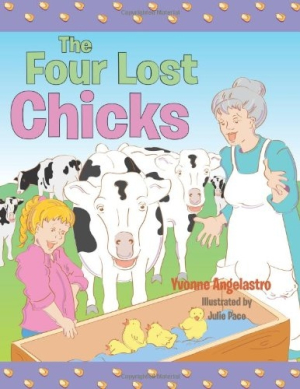The Four Lost Chicks
This charming story of rhythms and sounds teaches children about animals to foster reverence for nature.
The Four Lost Chicks, a cheerful picture book by school principal and grandmother Yvonne Angelastro, uses a short tale about a hen and her lost offspring both to entertain children and to foster respect for animals.
The story begins when a grandmother and granddaughter notice a distressed hen and seek out her wayward chicks by searching the farm calling, “Come Chi! Chi! Chick!” It’s a fun refrain repeated each time the two approach another part of the farm, and it adds a melodic, catchy rhythm to the narrative. Likewise, each time the grandmother and granddaughter encounter another farm animal in their search for the chicks, the author has included the appropriate “quacks,” “oinks,” “neighs,” and “moos”—sounds that children love to imitate.
The Four Lost Chicks not only provides a story that is fun to read out loud, but it also encourages reverence for living creatures. The grandmother consistently tells her granddaughter that the animals are smart and observant, as the two listen to the clues that lead them to discover the four chicks.
Illustrator Julie Pace has created colorful and dynamic visuals that move the entertaining story along. For example, just as the grandmother scatters corn kernels during their search for the chicks, Pace has bordered each page with a trail of kernels, giving the sense that the reader is present on the journey through the farm.
Angelastro has no doubt used her experience in education and as a mother and grandmother to construct a delightful story full of rhythms, sounds, and love for animals that is tailor-made for young children. As the back matter indicates, Angelastro’s memories of visiting her grandmother’s farm as a young girl inspired her to pen the story. The resulting glimpse at country living and the intimate relationships with animals will bring joy to readers young and old.
Reviewed by
Amanda McCorquodale
Disclosure: This article is not an endorsement, but a review. The publisher of this book provided free copies of the book and paid a small fee to have their book reviewed by a professional reviewer. Foreword Reviews and Clarion Reviews make no guarantee that the publisher will receive a positive review. Foreword Magazine, Inc. is disclosing this in accordance with the Federal Trade Commission’s 16 CFR, Part 255.

